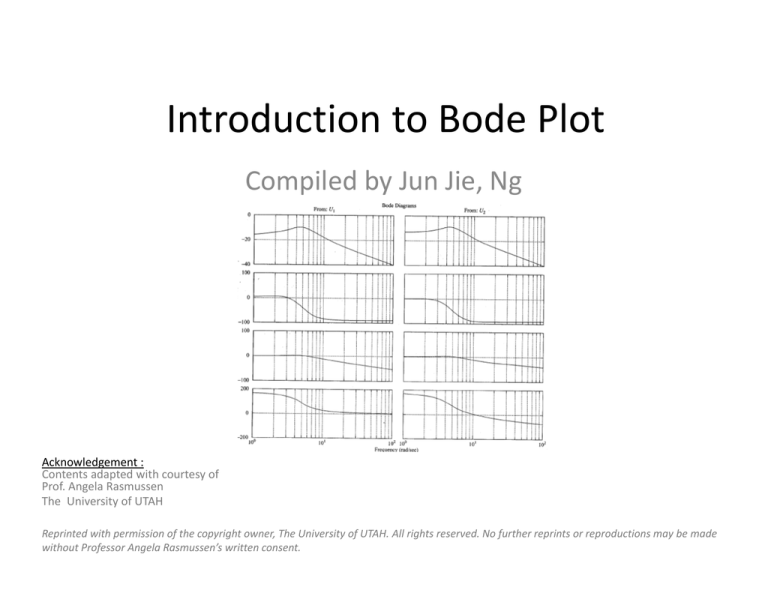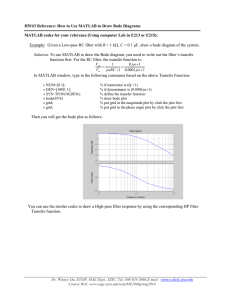
Introduction to Bode Plot Compiled by Jun Jie, Ng Acknowledgement : Contents adapted with courtesy of Prof. Angela Rasmussen The University of UTAH Reprinted with permission of the copyright owner, The University of UTAH. All rights reserved. No further reprints or reproductions may be made without Professor Angela Rasmussen’s written consent. References • Notes of Reference: http://www.ece.Utah.edu/~ece3110 • K. Ogata, Modern Control Engineering, Prentice Hall, 4th edition, 2002 • Follows closely to Professor Ben Chen’s EE2010E Lecture Notes, Aug 2009 in ‘Maths Derivation’ slides to help make revision easier. Purpose • The plot can be used to interpret how the input affects the output in both magnitude and phase over frequency. • Main advantage: multiplication of magnitudes can be converted into addition, and, a simple method for sketching an approximate log‐ magnitude curve is available. It is based on asymptotic approximations. Bode Plot Diagram Lines (1) • Normally, we know the transfer function. • We need to convert to the standard form. Bode Plot Diagram Lines (1) ‐
(Steps) • Normally, we know the transfer function. • We need to convert to the standard form. Q: How do we do this? Working:
Bode Plot Diagram Lines (2) • Replace s by jw (in this doc, sometime its represented as j?). • Then find the magnitude. Bode Plot Diagram Lines (3) • As you can see, to study bode plots, the following are important: Bode Plot Diagram Lines (4) • (1) Constant term, K. • Straight horizontal line of magnitude: 20 log10 (K) Q: Try the following using your calculator: 20 log10 (40), 20 log10 (20)… ? Bode Plot Diagram Lines (5) • (2) pole term. Bode Plot Diagram Lines (6) Maths Derivation • (2) pole term. Take: 20 log (H) -20dB
when frequency is
increased 10 times.
Bode Plot Diagram Lines (7) • (3) zero term. Bode Plot Diagram Lines (8) • Summarise abit... Bode Plot Diagram Lines (9) • Zeros and Poles not at the origin: To complete the log magnitude vs. frequency plot of a Bode diagram, we
superposition all the lines of the different terms on the same plot.
Example 1 ‐ (1) Example 1 ‐ (2) Example 1 ‐ (3) • Using MATLAB. >> num = [1];
>> den = [2,100];
>> bode(num,den)
title ('Bode Plot of Example 1')
Example 2 ‐ (1) Example 2 – Verify using MATLAB? Example 3 ‐ (1) Example 3 – Verify using MATLAB? Bode Plot ‐ Phase (1) • Our original transfer function. • Cumulative phase angle form. Bode Plot ‐ Phase (2) • Cumulative phase angle form as a function of frequency. Bode Plot ‐ Phase (3) • Effect of constant, K on Phase: no effect. • K<0 – will set up a phase shift of + 180 degrees • Effect of Zeros, s at the origin: • Cause +90 degrees shift Bode Plot ‐ Phase (4) • Effect of Poles, 1/s at the origin: • Cause ‐90 degrees shift Bode Plot ‐ Phase (5) • Poles not at the origin: • No phase shift for frequency much lower than p1, • ‐45 degree at p1 and • ‐90 degree at much higher frequency than p1 Bode Plot ‐ Phase (6) Maths Derivation • Poles not at the origin: Bode Plot ‐ Phase (7) • Zeros not at the origin: • No phase shift for frequency much lower than z1, • +45 degree at z1 and • +90 degree at much higher frequency than z1 Example 4 ‐ (1) Example 4 ‐ (2) Example 5 ‐ (1) Example 6 ‐ (1) Additional Practise More • There are bode plots for even higher orders of Transfer Functions, i.e. First order or Second order etc. • In the course, reading the plots to form the Transfer Function or vice‐versa is important. • It is strongly recommended to put some information on bode plotting into the cheating chit for exam. Second Order TF Bode Plot Second Order Transfer
Function:
Second Order TF Bode Plot – Maths Derivation MATLAB (for info) That’s all I have prepared for you… Hope it helps. Have Fun Learning Bode Plot!


